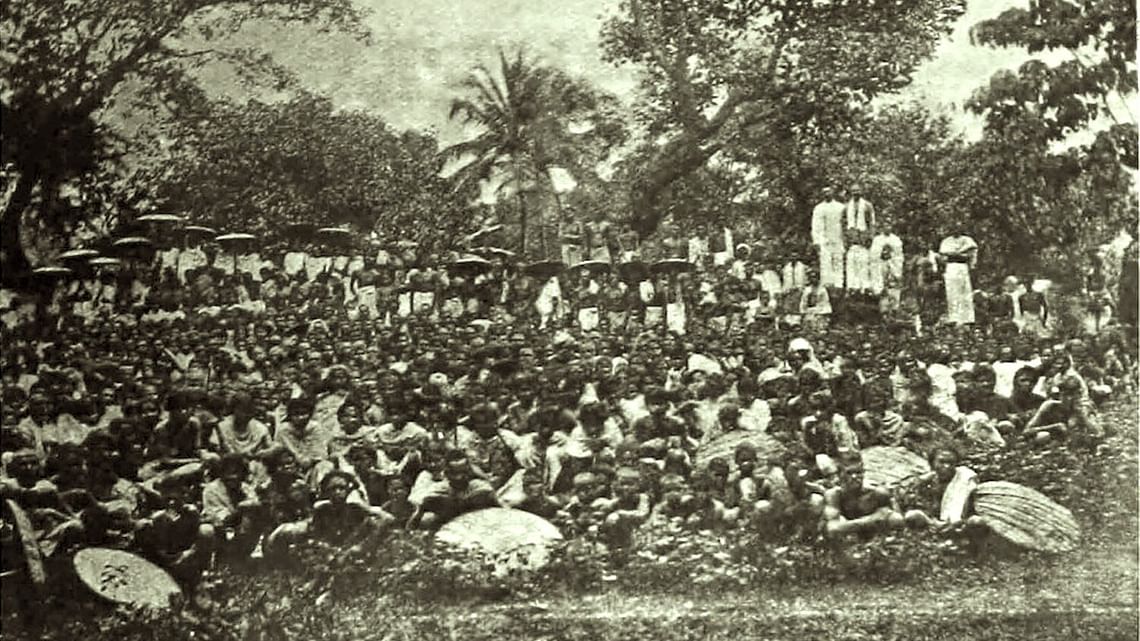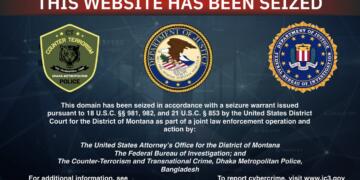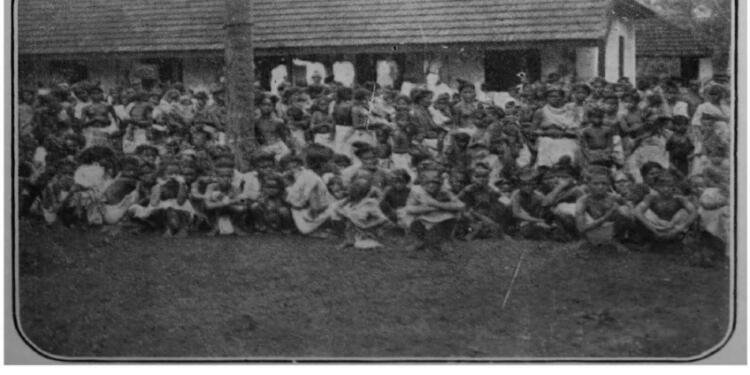In the earlier issues of dissecting the Moplah genocide of Malabar Hindus, we talked about how the genocide was minutely planned, with the chain of events set in place with the introduction of Moplah Muslims in the state, who started the mass conversion racket. Later, the Islamist father-son duo of Hyder Ali and Tipu Sultan took the barbarity to its crescendo with the final straw being the demise of the Ottoman empire. Indian political class (Read: Congress) intertwined the Indian independence movement with the Khilafat movement to churn a fatal concoction that led to the butchering of thousands of innocent Hindus.
To this day, the unholy nexus of communists and Islamists have kept the genocide under wraps with little to no mention in the cultural readings of the state or the country. Make no mistake, it was a pogrom against the Hindus but Marxist historians would make you believe that it was a peasant rebellion, a protest arising from the agrarian distress, or simply a crusade against the British raj.
10,000 or 2,500?
The number of Hindu deaths as a result of the genocide in Moplah amounted to around 10,000, and it is also estimated that over 100,000 Hindus were forced to leave Kerala in the wake of the massacre. However, the official records which the English officers took four months to compile state that only 2,500 Hindus were killed.
However, Mappilas, the original term that has been corrupted to Moplahs, didn’t kill the Hindus in an instant. The Islamists taking a cue from the book of their Arabic overlords aka the purebloods would ask if the person at the edge of the sword was willing to convert to Islam.

Convert to Islam or get killed
Mappilas didn’t take ‘no’ for an answer; and when the proud Hindu, even while facing death in its face would refuse to convert, they would slice the throat of the victim at that very moment.
On 9 November 1921, in a place called Vallikunnu, the Mappilas burnt around a hundred houses of Hindus. The bodies of Hindu men and children were dumped in the river.
The Tuvvur well incident is something that needs as much attention as the Wagon Tragedy. The Muslim rioters confined captured Hindu men and lined them up near a well in a place called Tuvvur. Each one of them was asked whether they were ready to convert to Islam. Those who were not ready to abandon their dharma were decapitated and thrown into the well.
Hindu temples razed
Not only the Hindus were killed and forced to flee, but close to 100 Hindu temples were also destroyed by Islamists during the genocide. On 9 November 1921, in a place called Vallikunnu, the Mappilas burnt around a hundred houses of Hindus. The bodies of Hindu men and children were dumped in the river.
One of the authentic references to the Moplah riots is found in the book of Diwan Bahadur C. Gopalan Nair. In the he book titled “The Moplah Rebellion 1921”, Nair mentions, “There is hardly a village that has not its temple, in the majority of villages there is more than one, and almost every temple in the rebel area has been desecrated.”
He further added, “No statistics have been compiled, but the number of temples destroyed or desecrated must exceed 100. The number is probably large, but for obvious reasons the Government have purposely refrained from attempting to collect accurate figures.”
International media coverage
While Indians had and still have a hard time digesting the reality of the genocide, the international media at the time had accurately reported it as a war against the Hindus.
The Telegraph on August 21, 1921, carried a report stating, “The Malabar rebellion is primarily a holy war. Green flags have been planted and there is forcible conversion of Hindus. Wholesale arson and looting is continuing and more murders have been committed. The non co-operation fanatics are proclaiming a complete swaraj and a famine is threatened consequent on the great destruction of the lines…”
The World, a newspaper published in Hobart, Tasmania, Australia carried the report dated October 8, 1921, as saying, “Calicut is overflowing with refugees reporting that the Moplahs are now not offering the choice of conversion, but are slaughtering Hindus indiscriminately. Reinforcement for the British troop guard is arriving…”
Annie Besant’s views on the barbarity
Annie Besant described the events in her book ‘The Future of Indian Politics’ as: “They murdered and plundered abundantly, and killed or drove away all Hindus who would not apostatize. Somewhere about a lakh of people were driven from their homes with nothing but the clothes they had on, stripped of everything. Malabar has taught us what Islamic rule still means, and we do not want to see another specimen of the Khilafat Raj in India”.
Vir Savarkar and BR Ambedkar’s views on the Hindu genocide
While Congress and its top leaders kept mum on the genocide of Hindus, it was Vinayak Damodar Savarkar that first raised his voice. He was one of the first ones to describe the Moplah rebellion as an anti-Hindu genocide through his semi-fictional novel Moplah.
Even Dr. B.R. Ambedkar has provided a detailed account on the rebellion in Pakistan or The Partition of India’
Ambedkar wrote in his book, “The Hindus were visited by a dire fate at the hands of the Moplas. Massacres, forcible desecration of temples, foul outrages upon women, such as ripping open pregnant women, pillage, arson and destruction— in short, all the accompaniments of brutal and unrestrained barbarism, were perpetrated freely by the Moplas upon the Hindus until such time as troops could be hurried to the task of restoring order through a difficult and extensive tract of the country.”
MK Gandhi – a mute spectator but a Moplah apologist
During the Congress session of Calcutta in 1920, ‘father of the nation’ Mohandas Karamchand Gandhi gave the slogan of ‘total non-cooperation’, under which the countrymen would not give any provide any cooperation to the British government at any level, and completely boycott all kinds of things related to the British.
Read More: 100 years of Moplah Riots and sadly nothing has changed in Kerala
Under this movement, Gandhi also wanted to prove to the British that people of every community could be united against them, and for this purpose, he invited the Khilafat Movement and its activists to join forces and subsequently participated in the Indian Freedom Movement.
However, after Hindus were tortured and killed in thousands, rather than condemning the Muslims, Gandhi called the Moplahs brave and patriotic for doing their duty. The upholding of Hindu Muslim unity meant that Hindu lives didn’t matter. Moplahs were brave and patriotic but there was no word about their butchered victims.
Gandhi said, “The Moplah revolt is a test for Hindus and Mussulmans. Can Hindus friendship survive the strain put upon it? Can Mussulmans in the deepest recesses of their hearts approve of the conduct of the Moplahs?… The Hindus must have the courage and the faith to feel that they can protect their religion despite such fanatical eruptions,”
The genocide of Hindus in Malabar was on a scale hitherto undreamt of. Documenting the real numbers would have been a Sisyphean task and it didn’t help that Congress and the Britishers were the one’s at the helm of power at the time.

































Thanks Abhinav, for bringing to light a gruesome incident from our recent past history.
The crime committed in the name of Moopla rebellion is celebrated in some quarters under other titles to this day. Many in present day Kerala or for that matter in India would rather bury their head in the sand. If we as a nation don’t learn from history, whom can we blame?
Once again thanks for the good work and pray that your tribe grows.
It’s a great sorrow and regret why we the Hindus then couldn’t crush the evil ! Respect to the Mahatma and deceit played by the evil hand so pathetic don’t know how the innocent reacted and gulped the bloody emotions so heinous. Shame on the leadership then and those elements even now. Great lessons! but time is still running out unless fortified all round by National concept and unity by Hindus by all means. Thanks